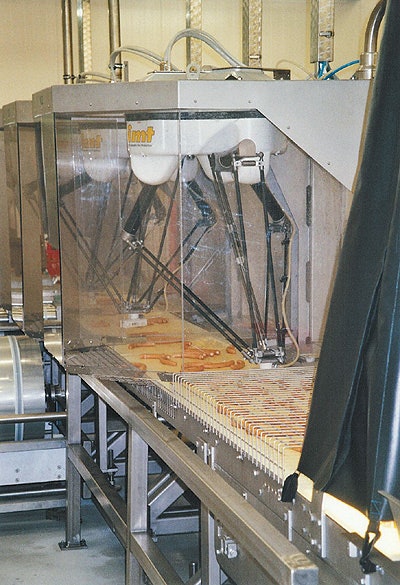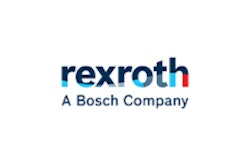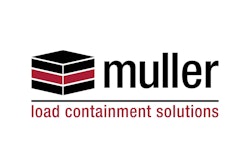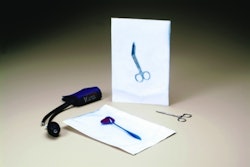At Sutter GmbH of Worrstadt, Germany, frankfurters are packaged in thermoformed plastic trays with a big boost from a “knowledge-based” robotic system called Ulixes. Developed by German integrator imt, this modular system combines robotic pick-and-place hardware, machine-vision technology, and a PC controller loaded with sophisticated image-processing and logistics software. It identifies randomly arranged frankfurters, groups them, and places them into thermoformed trays. The reduction in labor costs was described by Sutter vice president Harry Schmitt a short while after the system went into commercial production.
“About 850 kilograms [1꽋 lb] of frankfurters pass through the robot-equipped packaging system each hour,” explained Schmitt. “Directly next to the robot line, we also package 850 kilograms of frankfurters per hour, but this is done by 10 or 11 workers.” Since Schmitt made that comparison a year or so ago, all but two of those 10 or 11 workers have been redeployed elsewhere, and the frankfurter packaging they used to do is now done by a second robotic line that’s basically a duplicate of the first. This new line went in late last year. Like its predecessor, it’s managed by just two operators.
The Sutter operation is all the more impressive from an integrated packaging perspective because each line includes in-line thermoforming of trays, as well as evacuation and backflushing of trays, followed by heat sealing of lidding material to the trays in a modified-atmosphere packaging system. Convenience Food Systems provided the thermoforming/back flushing/lid sealing system. Refriger-ated shelf life of the packaged frankfurters is 28 days.
Like many robotics success stories, the installation at Sutter is a marriage of robotics and advanced machine-vision technology. A camera records the position of each frankfurter and relays this data to a PC. The PC uses customized image processing software to analyze the data. It then uses the data to coordinate the movements of five robots that ultimately transfer the frankfurters into their trays.
Two robot types
Two distinctly different robots are deployed. The actual placement of frankfurters into trays is performed by two turboscara SR8 robots from the Linear Motion and Assembly Technologies unit of Bosch Rexroth. But the Bosch systems are ably assisted by three ABB FlexPicker robots further upstream. Each FlexPicker uses its vacuum cup to pick individual frankfurters that are conveyed randomly from the smokehouse on a conveyor belt. The FlexPickers then set the frankfurters back down on the same conveyor in groupings of four frankfurters each.
Grouped frankfurters are conveyed to the two Bosch robots, which pick up where the FlexPicker left off. Relying once again on coordinates conveyed to them by the PC, each SR8 robot knows where it can find the two groups of frankfurters it’s supposed to pick up. Using the vacuum cups on its end effector, it swoops down and grabs the eight frankfurters. It then swivels to a freshly thermoformed tray in the CFS thermoform/seal machine that’s parallel to the conveyor belt from which product is picked. Four frankfurters are placed in one compartment and four in the other.
Other factors add to the complexity of all this. When lifting the frankfurters, the SR8 robots must be precisely synchronized with a product conveyor belt moving at a brisk 13 m/min (42’/min). Moreover, the pace of the CFS thermoform/seal system must also be synchronized. Only with precise and real-time data transmission to robots powered by a PC and its attendant software do the franks make their way to their designated trays.
Neural network
According to integrator imt, the Ulixes robotic system at Sutter is distinctly different from a mechanical pick-and-place operation because it represents what imt engineers call a “neural network.” In simplest terms, this means that the system functions in a similar way to the human brain. It “learns” from past decisions so that decisions in the future are even better than the ones it made in the past. Systems engineer Daniel Eisenhardt of imt elaborates on what makes the Ulixes system unusual.
“Logistics simulation software calculates the task to be done and assigns each robot what portion of the total task needs to be done by each. But the parameters of the task are extremely dynamic. First, the conveyor moving the product forward is in continuous motion. Second, the franks are not identical in length, curvature, or thickness. Third, if the vision system sees a frankfurter that is broken or too short or too long, a strategy for not picking that frankfurter must be developed and implemented.
“On top of all these possibilities, it’s possible that one of the FlexPickers may go into a self-cleaning mode, where the vacuum gripper is automatically driven into a cleansing solution, rinsed with water, and dried. When that happens, the other two FlexPickers have to compensate by picking all the frankfurters that would ordinarily have been picked by the robot being cleaned. The sensors and controls may have to slow down the infeed conveyor belt, too.”
The Ulixes system is uniquely suited to cope with these ever-changing circumstances, says Eisenhardt. Sensors, vision system, software, and PC controller join forces to recognize, plan, and respond with movements that are optimized with respect to object order, position on the belt, quantity, size, shape, thickness, and other characteristics. This what is meant by “knowledge-based” robotics.
Operating 24/7 with breaks scheduled for routine maintenance, the robotic packaging lines at Sutter represent a breakthrough for Bosch. Both turboscara robots had to be modified to fit into a food packaging setting, where thorough washdown is a daily occurrence.
Technical training was also required. “Two of our people attended training courses for the robot packaging system, so they can intervene in an emergency,” says Schmitt. “This knowledge is enough for the daily operation of the system, which is relatively simple despite the complex processes. That allows us to concentrate on the essentials of the production orders.”
Remote diagnostics
Remote maintenance and diagnostics were also built into the robotic system. This enables imt to intervene quickly via TCP/IP for maintenance and minor program corrections. The standard network provides the basis for internal and external communication with the robotic controls. This is something Schmitt says he can appreciate.
“Despite having modern robots, we didn’t have to hire specially trained technicians for the system to get direct help with minor interventions in the controls,” says Schmitt.
Company owner Hans-Joachim Sutter notes that in addition to cost savings and improvements in productivity, packaging frankfurters robotically also simplifies the measures that need to be taken to ensure that the packaging operation is suitably hygienic.
“When workers are involved in hand packaging,” says Sutter, “they have to pass through comprehensive disinfection barriers. Also, prescribed clothing, breathing masks, and shoes are required.”
On top of all that, the temperature in the 24/7 operation is kept at a chilly 55°F. “It isn’t easy to find workers in our business, yet we had to find a way to handle our growth,” says Sutter. Robots helped provide a solution.
Having dealt with automation technology now for many years in many phases of his business, Sutter is convinced that his firm’s investment in robotic packaging was the right call. “In our business, we need robots to save money and maintain hygiene,” he says. No wonder the decision to install the second robotic frankfurter line late last year was made so easily.


























